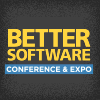Better Software Conference & EXPO 2005

PRESENTATIONS
|
Tips for Performing A Test Process Assessment
Looking for a systematic model to help improve testing practices within your team, department, or enterprise? Recently, Lee Copeland has led several, major test process assessment projects for both small and large test organizations. Whether you are chosen to lead an assessment project within your organization or just want to get better at testing, join Lee as he shares insights he has learned-beginning with the importance of using a proven assessment model. |

Lee Copeland, Software Quality Engineering |
|
Transitioning to Agile Development
The Agile development movement has started to transform the software landscape. Since February 2001 when the Agile Manifesto was published, Agile development has gone past the early adopter phase and now is regularly in use by such mainstream organizations as CapitalOne, the Federal Reserve Bank, Microsoft, Sun Microsystems, and major development departments in other organizations. |
|
|
Twelve-Step Program for a Better Test Process
We can't make software better by testing the quality into it. However, if we manage our testing processes and educate the rest of the team about what it takes to make better software, we can make a difference. First, we have to get the testing world under control and work to reasonable expectations; then, we can spread the word to the rest of the organization. Judy McKay describes how to gain control of the test process-while still getting the real work done-and shares ways to educate the rest of the team about quality awareness. |
|
|
Unitizing Legacy and New Code for Unit Testing
All code is unit testable, regardless of its origin and current state. Although it may not appear so, there are techniques you can use to safely get any piece of code under automated unit tests. Michael Feathers shows the dependency breaking techniques he has used to safely de-couple legacy code for unit testing. He discusses not only the different challenges in Java, C#, C++, and C but also common heuristics you can use to bring your code under test. |

Michael Feathers, Object Mentor |
|
Using Code Metrics to Target Refactoring
Often times, deciding what code to refactor (rewrite) is based upon the code's smell, a subjective determination by developers. Learn about and see examples of static analysis techniques such as cyclomatic complexity, depth of inheritance, and fan-in/fan-out to augment developers' instinct with real data. For example, cyclomatic complexity is adept at spotting methods containing too much conditional logic. Deep hierarchy trees, problematic for testing, can be broken out into separate objects. |

Andrew Glover, Vanward Technologies |
|
You've Just Been Named Manager of Software Process Improvement
We have all heard of the accidental project manager, but how about the accidental irocess improvement manager? If you have fallen into the role of process improvement, there are tips and tricks to help you navigate through sometimes treacherous waters. As a former quality assurance manager, Sandi Oswalt returned from maternity leave to be told she had a new job--process improvement. In response to her question about the goals for process improvement, her boss simply said, "Hmmm? . . . |
|


